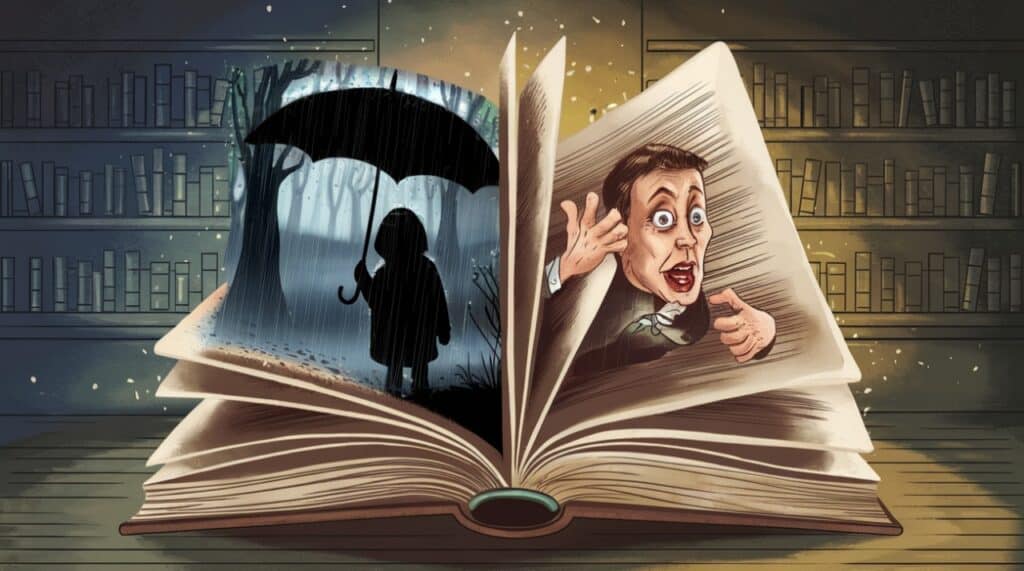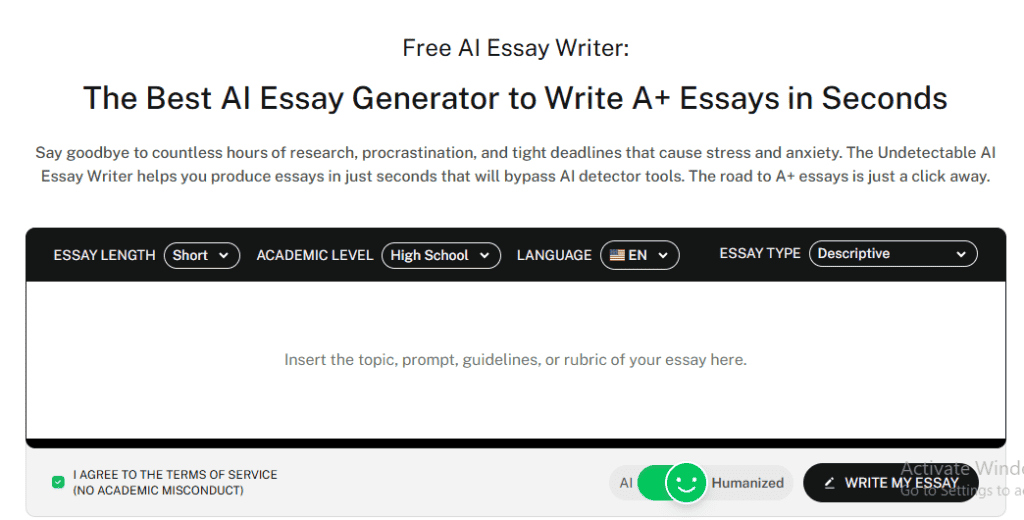In literature, the delivery of mood and tone serves to enrich the story while it connects readers to the narrative.
To successfully channel emotions such as fear, tension, excitement, or suspense in writing regardless of your writing skill and genre.
Your ability to control the mood vs tone dynamics in your work can help to create an unforgettable experience for your readers.
This piece will clear up your misunderstandings between tone vs. mood in literature and explain how you can improve your writing style. Let’s examine these details in depth.
What Are Mood and Tone in Literature?
Mood and Tone are two important literary components that help to enrich the storytelling process.
On the surface, the two elements can seem similar but they have different meanings in literature.
Therefore, you need to understand what each of these elements means separately before studying the relationship between mood vs. tone in literature.


Never Worry About AI Detecting Your Texts Again. Undetectable AI Can Help You:
- Make your AI assisted writing appear human-like.
- Bypass all major AI detection tools with just one click.
- Use AI safely and confidently in school and work.
Definition of Mood in Literature
The mood is the atmosphere the author creates in the story’s narrative.
While reading, your emotions can swing between tears and laughter as your heart races between anxiety, excitement, and other feelings you can’t explain.
In literature, the mood captures the emotional response the writer draws from the reader.
Many creative writers deliberately establish mood patterns in their work. It’s all about creating the experience readers feel while engaging with your work.
Sometimes, the author’s purpose may be to convey a constant tone throughout their work.
Definition of Tone in Literature
Like the mood, the tone influences the general atmosphere in the storyline.
As a writer, you can use tone to expose the reader’s emotions and creative intentions while building your work.
Every news article, scientific report, and inspiring memoir demands a unique writing style for the author to convey specific tones.
For instance, while reading a scientific report, you can easily spot the educational, critical, and serious tones in the author’s voice.
The tone emerges through the text which enables the reader to identify the author’s perspective.
It allows us to read between the lines, revealing the author’s sentiments about particular elements in the story.
Differences Between Mood and Tone

Imagine you walk into a gathering full of people wearing all black, sitting quietly, with some even crying.
From the setting alone, you can tell that something terrible has happened. Next thing, you hear a statement like, “he got what was coming to him.”
While the mood is melancholic, somber, and sorrowful, the speaker’s tone is spiteful, and doesn’t feel sorry for the subject.
In real life, it’s easy to pick up the mood vs tone while interacting with others.
This is because we can rely on social cues, facial expressions, and voice modulations to give more context.
However, there’s an ongoing debate about tone vs mood in literature because you only have the text to rely on.
You have to be able to read between the lines to avoid confusing one for the other.
For instance, in Charles Dickens’s “Hard Times,” he uses a witty, cynical, and ironic tone throughout the novel even though the mood he creates for readers is dreary and melancholic.
The topic of mood vs tone in literature is quite nuanced and plays a massive role in how the reader perceives a piece of writing.
To understand the differences in mood vs tone in a literary piece, you need to know where it comes from and its impact on the reader and narrative.
Source of Mood vs. Source of Tone
In a novel, the author creates the mood using different elements such as imagery, settings, tone, and plot narrative to get a reaction from the reader. As AI-generated visuals become more common, tools like AI Image Detector can help differentiate between authentic imagery and machine-created ones, ensuring creative integrity.
And yes, the tone contributes to the mood in a novel because the general atmosphere comes from the specific narrative and intricacies in the written work.
On the other hand, the source of the tone is more personal to you as the author.
It comes from your feelings, opinions, and attitudes about the specific themes being explored in the subject matter.
When it comes to tone, it all depends on the author’s choice of words, phrases used, and sentence structure throughout the piece.
Impact on Reader and Narrative
Depending on the end goal, many creative writers intentionally create the mood vs tone effect to get their readers to relate to specific themes of the story.
For instance, you may read a horror novel with graphic imagery and gory details.
Still, the author speaks childlike or adopts dark humor while telling the story.
The writer’s tone shows that the novel’s mood is humorous, not to spook you but to make you laugh.
In creative writing, the writer knows the impact they want to leave on the reader and weaves this intention into the story’s narrative.
However, it’s not always deliberate because you can say one thing, and others misinterpret the meaning. For instance,
let’s say you send a sarcastic text message without using emojis or memes to provide context. The recipient may likely think you’re being serious because it’s harder to convey tone through text alone.
That’s why you must be deliberate about leaving the right impact on the readers and narrative.
For instance, a writer’s authoritative and formal tone helps to create a more compelling and credible argument for the subject.
On the other hand, a speculative tone can leave readers feeling unsure and doubtful.
How Mood and Tone Work Together
Before you master mood vs tone, you must understand how these elements work together in literature.
While the tone refers to the author’s attitude in the narrative, the mood reflects the reader’s emotional response.
The relationship between mood and tone in literature determines how the reader feels about the story.
The tone blends into other elements in the plot to create a foundation for the story’s overall mood.
For instance, “The rain poured endlessly drenching the streets in a gray lifeless haze.” Here, the writer uses a melancholic tone, reflecting a gloomy mood.
It sets the narrative’s mood and influences how we feel about the subject, which, in this example, is the rain.
In literature, tone, and mood go hand-in-hand because these elements help to give a point of view and create an alternate reality for the reader.
They work together to shape how we experience the story and help make it more engaging.
Tools to Help Writers Master Mood and Tone
No matter what type of writing you do, you must master tone and mood in literature.
This helps to create an emotional connection with the reader and helps to make your writing stand out from the norm.
With the following AI-powered tools, you can effectively balance out the mood and tone in your piece with precision and creativity.
AI Essay Writer
Whether you’re working on an academic essay or a personal story, Undetectable AI’s essay writer can assist you in completing all your writing tasks.

It uses an advanced algorithm system to create creative and argumentative pieces. The tool is perfect for refining your ideas into a compelling piece, balancing the tone and mood.
AI Humanizer
Many formal or AI-generated write-ups sound robotic and impersonal, making it hard for the writer to connect with the reader.
The humanizer tool by Undetectable AI can help to adjust the mood vs tone to make it feel more engaging and natural.
It helps to revise the dialogue and improve the flow of your sentences.
Paraphrasing tool
Another essential writing tool that can help you effectively convey a better tone vs mood in literature is the paraphraser tool.
It allows you to maintain a consistent flow of thought by adjusting the text and sentences to intensify the mood.
For instance, you can make a statement like “The room looked dark,” while our Undetectable AI Paraphrasing tool changes it to “The room appeared gloomy and dreary.”
Examples of Mood vs. Tone in Literature
There are countless depictions of mood vs tone in literature, especially in classic works where many authors use these elements to enhance their storytelling.
Look closely at three classic examples of mood vs tone in literature.
Example 1: Edgar Allan Poe’s “The Tell-Tale Heart”
Edgar Allan Poe was known for his first-person narrative style, which he used to form an intimacy with his readers. In his short story “The Tell-Tale Heart,” the mood is primarily tense and eerie.
It shows the growing madness of the narrator as he desperately describes in chilling detail how he murdered the old man. Take this excerpt from the story:
“It is impossible to say how first the idea entered my brain, but once conceived, it haunted me day and night.”
The narrator’s tone here is desperate and defensive, revealing his paranoia and instability, which continues till his final words.
“I admit the deed! — tear up the planks! here! here! — it is the beating of his hideous heart.”
The mood vs tone works together in this narrative to evoke a sense of evil and danger in the reader. Poe’s setting and imagery are unsettling and intense throughout the story, leaving the reader on edge till the end.
Example 2: Jane Austen’s “Pride and Prejudice”
From the opening lines of Pride and Prejudice, Austen creates a warm atmosphere, building anticipation in her readers.
The story starts as light-hearted and funny, and as it takes shape, the mood becomes more romantic and hopeful.
Through the third-person narrative, readers experience a feeling of elegance and dreaminess of the characters as they attend glamorous balls, romantic evening walks, and explore beautiful countryside estates.
Even though the romantic elements shape the storyline, the narrator’s tone displays witty and satirical commentary on societal expectations during the Regency period.
“It is a truth universally acknowledged that a single man in possession of a good fortune, must be in want of a wife.”
You can sense Austen’s humorous nature in this opening statement as she makes fun of the social rules about marriage, as well as class and womanhood.
The contrasting romantic mood vs tone creates a dual effect that pulls readers deeper into the work while delivering an impactful social commentary.
Example 3: George Orwell’s “1984”
In George Orwell’s 1984, the atmosphere is heavily oppressive and bleak. Throughout the book, you can see the repeated use of the slogan “Big Brother is watching you.”
However, it feels more like a threat as you see the despair of Oceania’s citizens under the totalitarian government.
The writer also uses critical and foreboding to create a dark, ominous quality. It warns the characters to stay in line as they’re constantly under surveillance.
Through this portrayal, the reader develops intense intense feelings of paranoia since it shows how oppressive the society remains for its citizens.
FAQs About Mood and Tone in Literature
What Is The Difference Between Mood and Tone?
The mood focuses on the reader’s emotions and experiences while connecting with the literary work.
While, the tone refers to the author’s style in presenting the characters, settings, and subject matter.
How Do Authors Create Mood and Tone Simultaneously?
Many writers use various styles to connect the mood vs tone. These techniques include the choice of words, imagery, character study, rhythm, and sentence structure.
For instance, in a first-person narration, you can hear the author’s tone and attitude as you see things from the character’s point of view.
Can Mood and Tone Be Contradictory?
The mood and tone contrast is widespread in satirical literature.
For example, in Pride and Prejudice, the mood is eager and dreamy, while the author’s tone is sharp and quick-witted as she criticizes the societal rules in Regency England.
When the mood and tone contradict in this manner, it helps to create layers of meaning and irony in the story’s context.
Why Are Mood and Tone Important in Literature?
The Mood vs tone in literature helps to shape the reader’s perception of the story.
Many writers use literary forms such as mood, tone, imagery, and language to create depth in the story.
It also guides the reader’s interpretation and direction in the story’s narrative.
Conclusion
Grasping the elements of mood vs tone in literature allows you to appreciate the art of literary writing.
At Undetectable AI, we offer AI writing tools you can use to refine your tone and adjust the setting to keep the reader connected to your story.
We offer humanizing, essay writing, and paraphrasing tools to help you create authentic works that leave a lasting impression on your reader.
